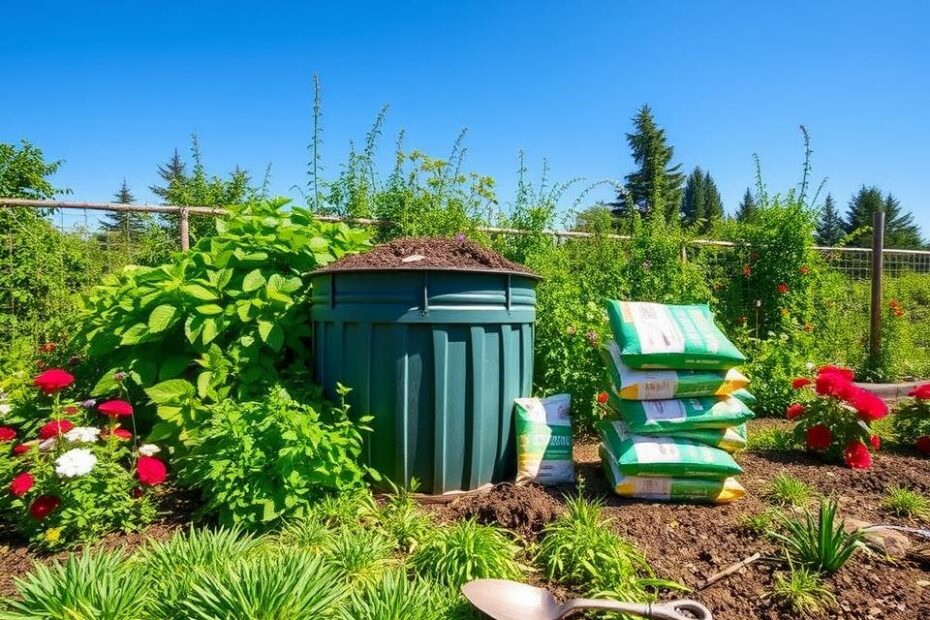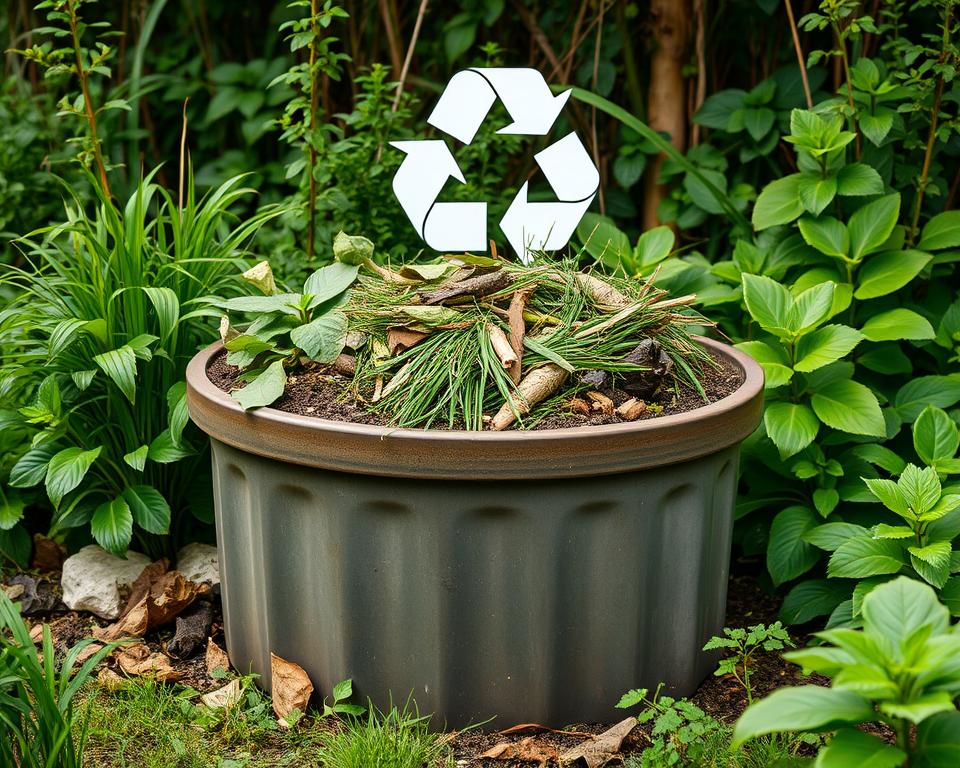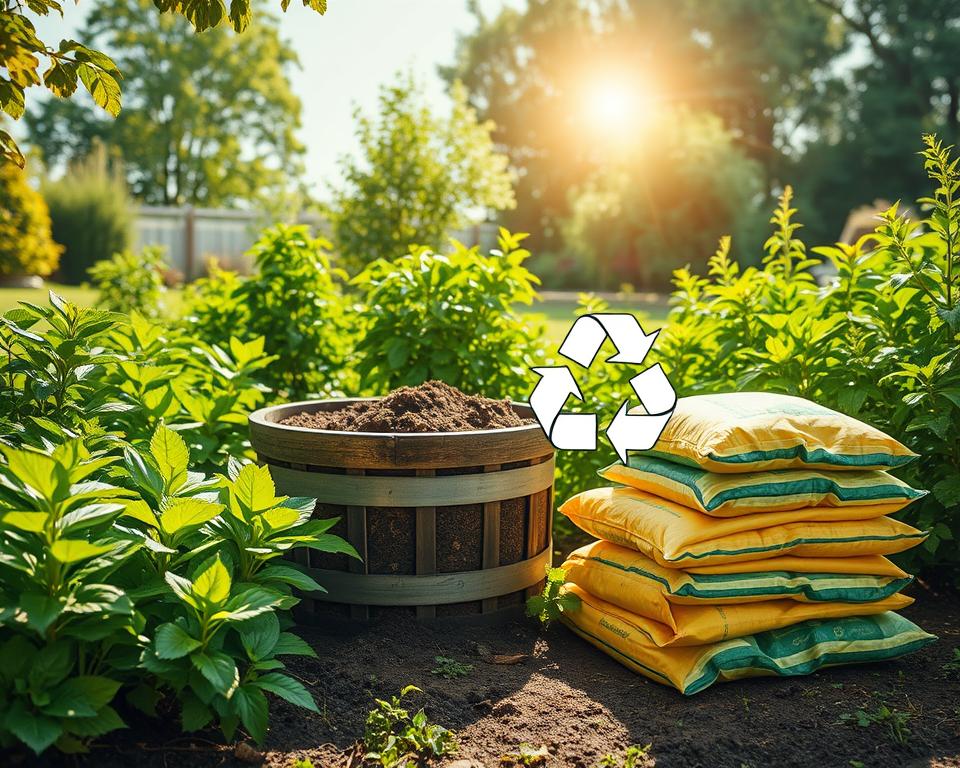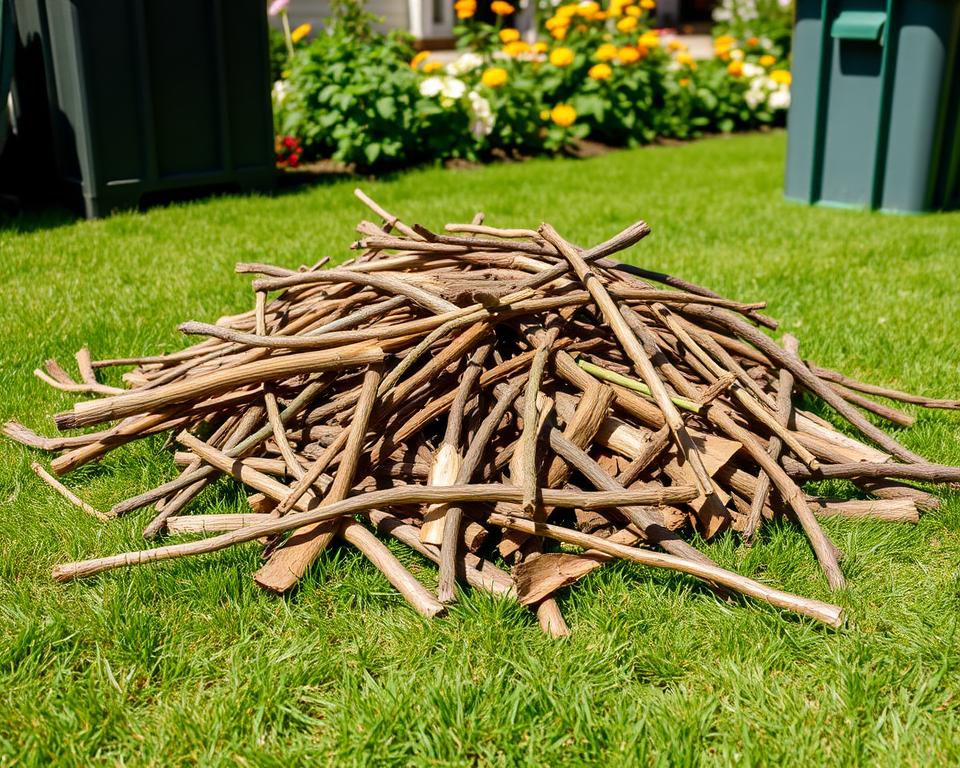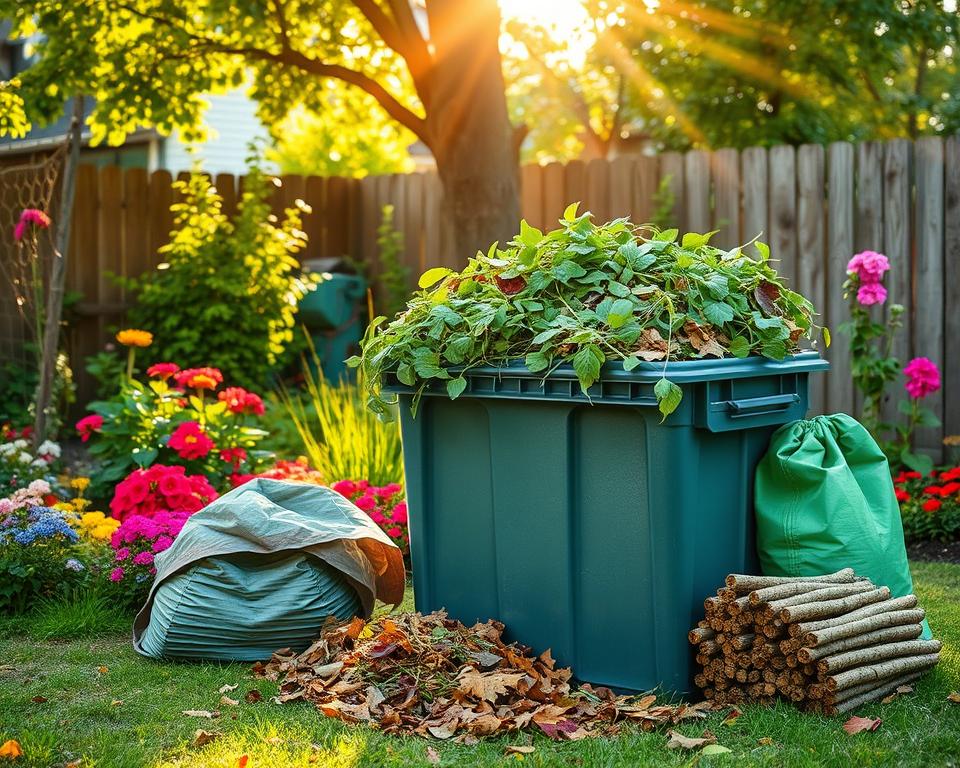As a passionate gardener, I’ve always been drawn to the vibrant colors and lush growth that a well-fertilized lawn can produce. However, over the years, I’ve come to realize that the proper disposal of garden chemicals, including fertilizers, is just as crucial as their responsible use. The impact our actions have on the environment and our community’s health is something we must all consider.
In this comprehensive guide, I’ll share expert insights on how to safely dispose of fertilizers and other garden chemicals, ensuring we protect our precious natural resources and safeguard the well-being of our loved ones. Whether you’re a seasoned green thumb or just starting to cultivate your outdoor oasis, this information is essential for making informed, eco-friendly choices.
Key Takeaways
- Proper disposal of fertilizers and other garden chemicals is crucial for environmental and community health.
- Understanding the laws and regulations surrounding hazardous waste disposal is key to responsible gardening practices.
- Improper disposal methods like pouring chemicals down drains or throwing them in the trash can lead to serious consequences.
- Safe disposal options include donating to neighbors, attending local hazardous waste events, and following packaging instructions.
- Choosing eco-friendly alternatives and implementing waste minimization techniques can help reduce the need for chemical fertilizers.
Understanding Garden Chemicals
Garden chemicals, including pesticides, weed killers, and fertilizers, play a crucial role in maintaining healthy and vibrant landscapes. However, the improper disposal of these substances can have severe consequences for the environment and human health. Let’s delve into the specifics of these garden chemicals and understand the importance of responsible disposal.
Pesticides
Pesticides are designed to control or eliminate pests that can damage plants or pose a health risk. They come in various forms, such as powders, baits, and sprays, and are often used to protect crops, gardens, and lawns. While pesticides can be effective, they can also be harmful if not handled and disposed of properly.
Weed Killers
Weed killers, also known as herbicides, are used to destroy or control unwanted weeds. These products are available in the form of sprays, liquids, or pellets/powders. Like pesticides, weed killers can be detrimental to the environment and human health if not disposed of correctly.
Fertilizers
Fertilizers provide plants with the essential nutrients they need to grow and thrive. They come in granules, powders, and liquids, and can be either organic or chemical-based. While organic fertilizers are generally safe to treat like yard waste, chemical and biosolid fertilizers pose a hazard, particularly in wastewater.
| Garden Chemical | Description | Disposal Considerations |
|---|---|---|
| Pesticides | Powders, baits, and sprays used to control pests | Hazardous waste, requires proper disposal |
| Weed Killers | Sprays, liquids, or pellets/powders used to eliminate weeds | Hazardous waste, requires proper disposal |
| Organic Fertilizers | Plant matter, animal remains, and naturally occurring minerals | Can be treated like yard waste |
| Chemical Fertilizers | Artificially produced nitrogen, phosphorus, and potassium | Hazardous waste, requires proper disposal |
| Biosolid Fertilizers | Produced from treated sewage sludge | Hazardous waste, requires proper disposal |
By understanding the various types of garden chemicals and their disposal considerations, gardeners can take the necessary steps to protect the environment and their own health. Proper handling and disposal of these substances is crucial to ensure a sustainable and safe gardening practice.
Laws and Regulations for Disposal
Proper disposal of garden chemicals is crucial due to the potential threat they pose to human health and the environment. Several federal laws and regulations govern the safe handling and disposal of these hazardous substances.
Federal Insecticide, Fungicide, and Rodenticide Act (FIFRA)
FIFRA mandates that products containing pesticides must have clear disposal instructions on their labels. This helps prevent illegal or improper disposal practices that could contaminate the surrounding ecosystem.
Resource Conservation and Recovery Act (RCRA)
RCRA establishes regulations for the management and disposal of hazardous waste, including garden chemicals classified as such. This ensures these materials are handled safely throughout their lifecycle, from generation to final disposal.
Hazardous Materials Transportation Act (HMTA)
The HMTA governs the transportation of hazardous materials, including garden chemicals, to prevent spills or accidents during the shipping process. This helps mitigate the environmental and health risks associated with the movement of these substances.
Clean Water Act (CWA)
The CWA aims to safeguard bodies of water from chemical pollution, ensuring that water quality is maintained by adhering to the act’s policies regarding proper disposal methods.
Comprehensive Environmental Response, Compensation, and Liability Act (CERCLA)
CERCLA provides a framework for responding to and holding parties responsible for environmental contamination caused by the improper disposal of hazardous substances, including garden chemicals.
By understanding and following these FIFRA, RCRA, HMTA, CWA, and CERCLA regulations, consumers can ensure the safe and responsible disposal of their garden chemicals, minimizing the potential harm to the environment and human health.
Importance of Proper Disposal
Improper disposal of garden chemicals like fertilizers can have severe environmental impact, health impact, legal consequences, and economic consequences. Responsible disposal is crucial to protect our planet, communities, and finances.
Environmental Impact
Fertilizers that are carelessly discarded can contaminate local ecosystems, water sources, and harm wildlife. Chemicals like nitrogen, potassium, and phosphorus in fertilizers can be deadly if consumed by fish and other animals, disrupting delicate natural balances.
Health Impact
Direct or indirect exposure to improperly disposed garden chemicals can lead to skin irritation, respiratory problems, and potential long-term health issues for humans. Improper disposal of fertilizers down drains or in the trash can also pollute water supplies, posing risks to the wider community.
Legal Consequences
Disposing of fertilizers and other garden chemicals illegally, such as by pouring them down the sink or storm drain, can result in hefty fines and penalties. Violating hazardous waste regulations can even lead to criminal charges in some cases.
Economic Consequences
The aftermath of improper disposal can be costly. Cleaning up areas heavily polluted due to careless waste management requires significant resources, often funded by taxpayer money. Businesses may also face reputational damage and lose customers due to their role in environmental contamination.
By prioritizing proper disposal of garden chemicals, individuals and businesses can protect the environment, public health, avoid legal troubles, and mitigate financial burdens. Responsible pollution prevention is essential for a sustainable future.
| Consequence | Impact |
|---|---|
| Environmental | Ecosystem contamination, harm to wildlife |
| Health | Skin irritation, respiratory issues, long-term health problems |
| Legal | Fines, penalties, criminal charges |
| Economic | Costly cleanups, reputational damage, financial burden |
Safe Disposal Methods
Safely disposing of old or unused garden chemicals and fertilizers is crucial for protecting the environment and your community. Fortunately, there are several responsible options to consider when it’s time to get rid of these potentially hazardous materials.
Donating to Neighbors or Local Businesses
If the fertilizers or other products are still in good condition, you can donate them to neighbors or local small businesses that could utilize them. This helps reduce waste and ensures the materials are put to good use.
Local Hazardous Waste Disposal Events
Many communities host periodic hazardous waste disposal events where residents can safely and properly dispose of gardening chemicals, fertilizers, and other hazardous items. Check with your local authorities to find out about upcoming collection days in your area.
Following Packaging Instructions
When disposing of fertilizers, be sure to carefully read and follow any disposal instructions provided on the product packaging. This will help ensure the materials are handled in a way that minimizes environmental impact.
Professional Disposal Services
For larger quantities or more hazardous materials, seeking the services of a professional chemical waste disposal company is recommended. These experts have the proper training and equipment to handle the safe disposal methods required.
By exploring these various options, you can safely and responsibly get rid of old or unused fertilizers and other gardening chemicals, protecting both the environment and your community.
Improper Disposal Methods to Avoid
Proper disposal of garden chemicals and fertilizers is crucial to protecting the environment and public health. However, many homeowners may unknowingly resort to improper disposal methods, unaware of the potential consequences. It is essential to avoid these careless practices to maintain a clean and safe ecosystem.
One common mistake is pouring chemicals down the drain. This can contaminate water sources and harm aquatic life. Similarly, throwing fertilizers and pesticides in the regular trash can be detrimental, as these hazardous materials may pose risks to sanitation workers and pollute landfills.
- Avoid pouring chemicals down the drain to prevent water contamination.
- Refrain from throwing garden chemicals in the regular trash, as this can harm sanitation workers and the environment.
Another improper disposal method is burning chemical containers, which can release toxic fumes into the air. This practice should be strictly avoided, as it can have severe consequences for both human health and the environment.
Lastly, pouring chemicals directly onto the ground can lead to soil and groundwater contamination, harming local ecosystems. This irresponsible disposal method should be completely avoided.
- Steer clear of burning chemical containers, as it releases harmful toxins into the air.
- Refrain from pouring chemicals directly onto the ground, as this can contaminate soil and water sources.
By understanding and avoiding these improper disposal methods, homeowners can play a crucial role in maintaining a healthy and sustainable environment. Responsible disposal practices are essential for preserving the delicate balance of our ecosystems and safeguarding the well-being of our communities.
| Improper Disposal Method | Potential Consequences |
|---|---|
| Pouring chemicals down the drain | Water contamination, harm to aquatic life |
| Throwing garden chemicals in regular trash | Risks to sanitation workers, environmental pollution in landfills |
| Burning chemical containers | Release of toxic fumes, air pollution |
| Pouring chemicals directly onto the ground | Soil and groundwater contamination, harm to local ecosystems |
Dispose Fertilizer Safely
When it comes to properly disposing of fertilizers and other garden chemicals, safety should be the top priority. Proper handling and disposal methods are crucial to protect the environment and public health.
Handling Pesticides
For pesticides specifically, it’s important to keep them in their original containers to avoid confusion and potential misuse. Pesticides and other hazardous garden chemicals should never be poured down drains or thrown in the regular trash, as this can lead to serious environmental and health risks.
Options for Proper Disposal
- Find a new home for the unused products by donating them to neighbors or local businesses that can still use them.
- Attend a county hazardous waste collection event, where you can safely dispose of pesticides and other chemicals.
- Contact your state’s Department of Agriculture to inquire about any special pesticide disposal programs they may offer.
- Check the packaging instructions for guidance on the proper disposal method recommended by the manufacturer.
- Utilize professional disposal services, which can safely handle the transportation and destruction of your old fertilizers and pesticides.
When transporting old fertilizers and pesticides for disposal, it’s crucial to handle them with care to avoid airborne dust and harmful fumes. By following these safe disposal methods, you can help protect the environment and minimize the risks associated with improper safe fertilizer disposal, pesticide handling, and proper fertilizer disposal options.
Hazardous Ingredients and Potential Hazards
Fertilizers, both chemical and organic, can contain a variety of hazardous ingredients that pose potential risks to human health and the environment. Understanding these hazardous components is crucial for ensuring safe handling, storage, and disposal.
Common hazardous ingredients found in chemical or synthetic lawn and garden fertilizers include ammonium nitrate, ammonium phosphate, ammonium sulfate, copper salts, lime, pesticides, and potassium chloride. These types of fertilizers tend to be water-soluble and concentrated, making them easily overused and more likely to end up in waterways after rain or watering.
Potential hazards associated with these hazardous fertilizer ingredients include being harmful if ingested, as well as being corrosive to the skin, eyes, and mucous membranes. Both chemical and organic fertilizers can also pollute surface and groundwater if not used and disposed of properly.
| Hazardous Ingredient | Potential Hazards |
|---|---|
| Ammonium nitrate | Explosive, corrosive, toxic if ingested |
| Ammonium phosphate | Corrosive, irritating to skin and eyes |
| Ammonium sulfate | Corrosive, irritating to skin and eyes |
| Copper salts | Toxic if ingested, damaging to aquatic life |
| Lime | Corrosive, irritating to skin and eyes |
| Pesticides | Toxic, carcinogenic, harmful to wildlife |
| Potassium chloride | Irritating to skin and eyes, harmful if ingested |
By being aware of these hazardous fertilizer ingredients and their potential fertilizer hazards, users can take appropriate precautions to minimize exposure and ensure the safe handling, storage, and disposal of chemical and organic fertilizers.
Storage and Use Guidelines
Proper storage and use of fertilizers are crucial to ensure the safety of your garden and the environment. By following a few simple guidelines, you can minimize the risks associated with fertilizer handling and enjoy a healthy, lush lawn or garden.
Safe Storage
Fertilizers should be stored in a secure, dry location, away from children, pets, and sources of moisture. Keep them in their original, tightly sealed containers, and never store them in areas with high foot traffic. Regularly inspect the storage area for any signs of leaks or damage to the containers.
To further enhance safety, store fertilizers separately from other chemicals, such as pesticides or herbicides. This helps prevent cross-contamination and reduces the risk of accidental mixing. Ensure that the storage area has proper ventilation and is equipped with a secondary containment system to contain any potential spills.
Proper Use
When applying fertilizers, always follow the instructions on the label carefully. Wear protective equipment, such as gloves, and avoid applying fertilizers during heavy rain or immediately before a storm, as this can lead to runoff and contamination of nearby water sources.
Use a slow-release fertilizer with at least 50% of the nitrogen in an insoluble form, and apply no more than 1 pound of actual nitrogen per 1,000 square feet per application. This helps ensure that the nutrients are released gradually, reducing the risk of over-fertilization and minimizing the impact on the environment.
Alternatives to Reduce Fertilizer Use
- Consider using organic, slow-release fertilizers like compost or manure, which provide a more gradual and balanced nutrient release.
- Incorporate native, drought-tolerant plants into your landscape, as they often require less fertilizer and irrigation.
- Practice eco-friendly lawn care techniques, such as aerating, overseeding, and mowing at the appropriate height, to reduce the need for chemical fertilizers.
- Explore alternatives like seaweed extracts, which can provide nutrients without the risk of over-application.
By following these fertilizer storage guidelines, proper use recommendations, and exploring eco-friendly alternatives, you can contribute to a healthier, more sustainable lawn and garden while minimizing the environmental impact of your lawn care practices.
| Fertilizer Storage Guideline | Benefit |
|---|---|
| Store fertilizers in a secure, dry location | Reduces risks associated with release through broken containers, irresponsible use, outdated materials, and combustion |
| Keep fertilizers separate from other chemicals | Minimizes risks of nutrient contamination in water sources and poor water quality due to algae blooms |
| Ensure containment areas can confine at least 125% of the largest bulk container contents | Provides a safeguard against spills and leaks |
| Designate dedicated fertilizer storage areas, away from plant material and high traffic | Reduces risks in handling fertilizers |
| Regularly inspect containers for damage and repackage or replace as needed | Maintains the integrity of the fertilizers and prevents leaks or contamination |
Conclusion
In conclusion, the proper disposal of fertilizers and other garden chemicals is crucial for protecting the environment, human health, and avoiding legal and economic consequences. By understanding the various types of garden chemicals, the relevant laws and regulations, and the importance of responsible fertilizer disposal summary, individuals and businesses can take the necessary steps to safely handle and dispose of these products.
The key is to avoid improper disposal methods, follow packaging instructions, utilize community safe disposal best practices events, or seek professional disposal services when needed. Adopting sustainable gardening practices that reduce or eliminate the need for chemical fertilizers can also help minimize the environmental protection. Overall, by prioritizing safe and eco-friendly disposal of garden chemicals, we can safeguard our communities and ecosystems.
Proper responsible chemical handling is not only a legal requirement but also a moral obligation to ensure the health and well-being of our planet. By adhering to the guidelines and seeking expert assistance when necessary, we can collectively make a positive difference in reducing the environmental impact of garden chemicals.
FAQ
What are the different types of garden chemicals?
Garden chemicals consist of fertilizers, weed killers, and pesticides. Pesticides are used to control or eliminate pests, weed killers (herbicides) destroy or control unwanted weeds, and fertilizers provide plants with necessary nutrients.
What are the laws and regulations surrounding the disposal of garden chemicals?
Several laws and regulations govern the proper disposal of garden chemicals, including the Federal Insecticide, Fungicide, and Rodenticide Act (FIFRA), the Resource Conservation and Recovery Act (RCRA), the Hazardous Materials Transportation Act (HMTA), the Clean Water Act (CWA), and the Comprehensive Environmental Response, Compensation, and Liability Act (CERCLA).
What are the consequences of improper disposal of garden chemicals?
Improper disposal of garden chemicals can lead to serious environmental and health impacts, including contamination of ecosystems, water sources, and harm to wildlife. It can also result in legal consequences, such as fines and penalties, as well as economic consequences for businesses, such as costly cleanups and reputational damage.
What are some safe and responsible ways to dispose of old or unused garden chemicals?
Safe disposal methods include donating usable products to neighbors or local businesses, participating in community hazardous waste disposal events, carefully following packaging instructions, and seeking the services of a professional chemical waste disposal company for larger quantities or more hazardous materials.
What are some improper disposal methods that should be avoided?
Improper disposal methods to avoid include pouring chemicals down the drain, disposing of them in regular trash, burning chemical containers, and pouring chemicals directly onto the ground, as these practices can have severe environmental and health consequences.
How should pesticides be handled and disposed of?
Pesticides should be kept in their original containers to avoid confusion and potential misuse. They should not be poured down drains or thrown in the regular trash. Instead, options for proper disposal include finding a new home for the products, taking them to a hazardous waste collection event, or contacting the state’s Department of Agriculture for any special pesticide disposal programs.
What are some common hazardous ingredients found in chemical or synthetic lawn and garden fertilizers?
Common hazardous ingredients in chemical or synthetic fertilizers include ammonium nitrate, ammonium phosphate, ammonium sulfate, copper salts, lime, pesticides, and potassium chloride. These types of fertilizers can be harmful if ingested, corrosive to skin and eyes, and can pollute surface and groundwater if not used and disposed of properly.
How can fertilizers be stored and used safely?
To ensure the safe storage and use of fertilizers, it is important to follow label instructions carefully, use them in moderation, and store leftover fertilizer tightly sealed in a clearly labeled plastic bag in a secure area. When applying fertilizers, wear protective equipment and avoid doing so if heavy rain is predicted to prevent runoff. Gardeners can also consider using slow-release or eco-friendly alternatives to reduce the need for chemical fertilizers.
